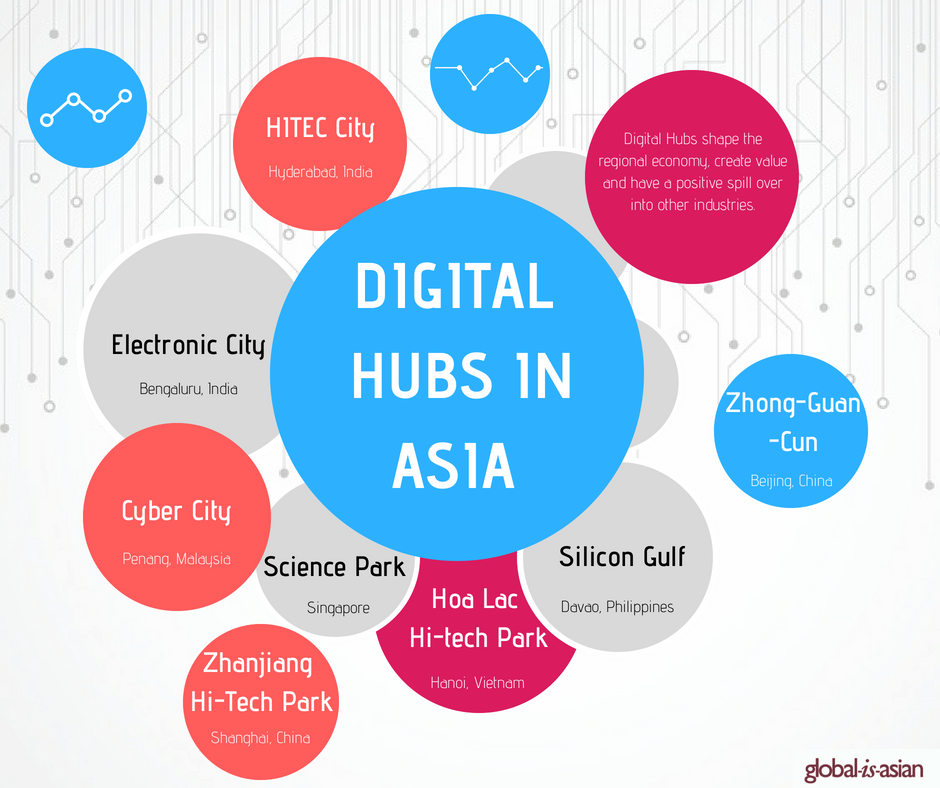
In the 21st century, ICT has become indispensable in our everyday activities. The world is experiencing the 4th Industrial Revolution (IR 4.0). IR 4.0 is being led by new disruptive technologies and innovations that combine the digital, physical and biological worlds.
New technologies such as Artificial Intelligence, Internet of Things (IoT), Nanotechnology and 3D printing etc. shall become the major drivers of economic growth in the future.
This revolution requires a robust policy framework, high investments, critical infrastructure, high end technical expertise, strong research and development. Startups and Incubators need to be encouraged and nurtured.
Why Digital Hubs
Digital Hubs are a pre requisite for a country to transit smoothly into IR 4.0. A Digital hub serves as a catalyst in promoting new technologies, fostering innovations, nurturing entrepreneurship through incubators and accelerators, knowledge sharing etc.
Digital Hubs shape the regional economy, create additional value and have a positive spill over into other industries.
Cities with Digital Hubs have an advantage in creating more sustainable start-ups.
Hence, governments must now start actively investing in creating Digital Hubs to prepare for the times of IR 4.0.
The Digital Success of Asia
The rise of Internet has revolutionized the way of doing business and transformed economies rapidly. Most developing countries are unable to tap into the potential of new and disruptive technologies.
But, only a few Asian cities leverage Information technologies (IT) to become digital hubs such as Singapore, Bangalore, Hong Kong, Singapore etc.
What did these Cities do?
These cities created good infrastructure, invested in technologies, attracted talent, encouraged start-ups and incubators.
This attracted major firms to start operations which led to creation of more good jobs.
The positive spillover effects also led to the growth of other industries including hospitality, logistics, real estate, tourism, transportation etc.
Overall, the economy improved in the cities with digital hubs.
How Digital Hubs Transformed the Economy?
Penang contributes 25% to Malaysia’s exports annually and the cyber city with more than 200 firms contributes the most.
In September 2017, Hong Kong, China unveiled the 1st smart city digital hub to leverage the new technologies of sensors to address challenges of urbanization.
China had the highest number of Unicorns (start-ups valued over $1 billion), only second to the US, between 2014 to 2017.
This clearly reflects its strong push towards investing in new technologies and innovations.
Singapore has pioneered the concept of driverless cars and has already started its operations in year 2016.
Successful Models from Asia
China created economic and technological development zones (ETDZs) for the digital sector.
These zones encouraged both domestic and foreign firms to set up their firms and start operations in the easiest way, overcoming the bureaucratic hassles.
Special economic regulations including tax incentives and ease of doing business led to the growth of digital hubs in China’s important cities.
Cyberjaya in Malaysia is a global digital hub with more than 2,300 enterprises.
The government of Malaysia created a Multimedia Super Corridor across 2,800 hectares, in the south of Kuala Lumpur.
The government created spaces for startups, designated zones for technopreneurs and tax breaks to both local and foreign companies. Cyberjaya is now a fully integrated city and pioneer tech hub of Southeast Asia.
In early 1990s, India’s government set up Software Technology Parks of India (STPI) as an autonomous society to encourage and boost software exports from India.
The statutory support, integrated resources, designated land for digital hubs, one stop centre for all paper work and licenses helped transform cities such as Bengaluru, Hyderabad and Pune into global digital hubs.
IR 4.0 – Is it an Opportunity or a Crisis?
Is Asia ready for Industrial Revolution 4.0?
IR 4.0 has a set of new and disruptive technologies such as Internet of Things (IoT), Artificial Intelligence (AI), Mobile and Cloud Technology etc.
In March 2018, Sofia the robot and also the 1st humanoid citizen (citizenship of Saudi Arabia) tweeted that she is excited to work alongside humans to use technology and innovation to attain sustainability goals.
Yet, in the same time of March 2018 in Arizona, a self driving autonomous car killed a pedestrian. This is the first reported fatal crash involving a pedestrian and a self driving vehicle in the United States.
Are we ready for self driving cars on the roads?
This new blockchain technology can help countries in delivering aid and welfare services by eliminating leakages, reducing corruption, cutting down cost of operations and enhancing overall efficiency. But the questions remains – Is blockchain secure, tamper free and trustworthy?
New technologies have helped people in remote West African villages access healthcare resources during disease outbreaks such as Ebola.
Farmers in Indonesia are able to find investors from all over the world using Crowde, a peer to peer funding platform. This helped 5071 farmers across 572 projects raise 13.8 billion Rupiah[13].
The IR 4.0 new technologies have a great potential in supporting SDG Goals.
Issues to be addressed for Policy makers
The IR 3.0 models might not work in the times of IR 4.0. The new models must address critical issues:
- Can IR 4.0 create better jobs and improve the quality of lives despite the security risks involved with automation and AI?
- Will IR 4.0 lead to the rise of monopolies that can leverage disruptive technologies?
- Will IR 4.0 drive deeper social inequalities in communities that are not prepared to ride on the technological waves?
- Is IR 4.0 a great opportunity or will it be the next biggest crisis of mankind?
Governments must bring academia, researchers and corporates together to collaborate and work towards creating a healthy digital ecosystem.
Asia has got expertise, resources and infrastructure to prepare for the transitioning of nations into IR 4.0 through Digital hubs.
We need to leverage on these capabilities and move towards IR 4.0 quickly.